<<back
Lesson Plan BRUNEI
A. Brunei
A.1. Water and environmentally sustainable development
A.1.1. Overview and background information:
Title of the lesson
- Unit/Topic : Matter
- Sub-topic: The earth’s resources
Background/context for particular lesson:
- Learners’ pre-requisite knowledge should include the concepts of mass and volume and know how to measure them using specific laboratory instruments, such as, measuring cylinder, beam balance and electronic balance.
- This should be related to the existence of water as an example of matter, in terms of its quantity and abundance.
- Due to its vast content on earth and various uses, it demonstrates how essential it is to not only humans, but life on earth as a whole.
Learning goals in the core learning area:
- To recognize usefulness of scientific methods and apply skills such as interpreting and drawing graphs and charts to classroom and everyday life;
- To develop an informed interest in scientific matter, particularly that is related to the environment and demonstrate positive attitude towards its protection.
Teachers Notes:
- In Brunei, World’s Water Day (22nd of March) is commemorated annually and for the occasion, a series of events/activities are organized by JKR (the Water Works Dept under the Ministry of Development in Brunei).
A.1.2. The Lesson Plan
Subject Matter area |
Science |
Time duration |
Topic |
Earth’s resources |
|
Grade |
6 (Learners between the ages of 12-13 years old) |
|
Specific concepts covered in the lesson |
- Definition of Matter, which include earth’s resources
- Earth’s resources being renewable/ exhaustible
|
|
Human values addressed |
- Understanding towards the importance of clean water and reducing wastage
- Caring towards the environment and acting on how to protect and to conserve earth’s resources (particularly water)
|
|
Lesson objectives |
At the end of the lesson, learner should be able:
- To list down some of the earth’s resources (cognitive)
- To state the abundance of the earth’s resources, e.g. water (cognitive)
- To explain the everyday uses of some of the earth’s resources and their exhaustibility (cognitive)
- To express positive attitude about the value of water by producing recommendations on how to conserve it (affective)
|
|
Materials needed |
- Satellite picture of earth
- PowerPoint Presentation (Projector and Laptop)
|
|
Teaching-Learning Steps: |
40 mins |
Introductory or motivational activities |
- Inquire from learners the meaning of matter, which is anything that has mass and occupies space (volume).
- Explain that water, soil, air, plants and animals are all matter; and that matter is found everywhere on earth.
- Provide learners a satellite picture of the earth and ask them what the blue parts represent. Learners should be able to know that these blue parts are bodies of water, and they cover about 70 % of the earth.
|
5-7 mins |
Lesson Proper |
Step 1: Direct questioning and short teaching
- Using Microsoft PowerPoint (Attachment 6.A.1.1), show facts about the earth’s water supply.
- Then, by asking learners to construct a pie chart to see how much is the percentage of water that is available for human use.
- Emphasize that only 2.8% of water is fresh water. Relate this to the need to conserve water.
- Ask learners ‘How do we do this?’ We use a bottle of water (only 0.08% of it) to infer that a small percentage of the earth’s water is freshwater, which is available for direct human consumption (analogy).
- Explain to learners that earth’s resources may either be renewable or exhaustible. Provide definitions in the form of handouts (teachers need to prepare this).
- Provide learners with a list of substances and instruct them to classify these substances into renewable/ exhaustible (Attachment 6.A.1.2) in small groups.
|
5-7 mins |
|
Step 2: Personality Quiz Activity (Linkage with human values)
- Provide learners with the ‘personality quiz’ work-sheet (Attachment 6.A.1.3). Give learners ample time to answer it individually. Emphasize on learners giving honest answers and that they will not be reprimanded for giving ‘bad’ answers.
- Once the learners have completed the quiz, discuss the answers by allowing learners to express their views and opinions about good and bad habits of caring for water.
- Ask them: 1) if the quiz has made them realize something new about their water habits. 2) Are their habits (based on their answers) good or bad? 3) Are learners willing to change their behaviour for the sake of saving water?
- Teacher should provide feedback in the form of explanation, using Microsoft PowerPoint or Transparency, on Conservation Tips (Attachment 6.A.1.4).
|
10-15 mins |
Closure |
- Show by using PowerPoint or Transparency on some water facts titled “How much water does it take to…” (Attachment 6.A.1.5).
- Include the fact that each gallon is equal to ~ 4.54609 L.
- Emphasize the importance of water conservation and that it is our responsibility as the inhabitants of the earth to conserve it (Linkage with human values).
|
5-10 mins |
Assessment / Evaluation |
- Create a critical thinking activity (write-up assignment) which involves analyzing process in learners with the following scenario:
- “You are living in a community which lacks water supply. You want the people living in the neighborhood to appreciate water. Explain how you would set up a campaign in order to educate the people about it”. Write a passage of not more than 100 words.
|
If there is extra time, do as home-work
|
Attachment 6.A.1.1
Power Point: The Earth’s Water Suppy



Attachment 6.A.1.2
Below is a list of substances.
Identify which are renewable and exhaustible.
List of substances |
Carbon dioxide Sand Paper
Fuel Oxygen Iron
Methane Gas Ice Plastic
Water Wood Nutrients |


Attachment 6.A.1.3
Personality Quiz – How much do you value water?
1. You saw running water at the cafeteria sink. You were already late for class. Do you:
A. rush to the cafeteria and make sure you close the tap, even though you know you were already late?
B. run to class to inform the teacher about it so that he/she will take action?
C. ignore it, thinking it should be the cafeteria staff’s responsibility to close the tap, not you?
2. You always bring your water bottle to school. One day when you return home, you realize that you still have some water left in it. Do you:
A. keep the remaining water so that you can use it for later?
B. ask your sister/brother to finish it up?
C. throw it? You like your bottle to be refilled with ‘fresh’ water every day.
3. Do you let the water run when you brush your teeth in the sink?
A. Never. I try to remember to close the tap every time.
B. I will only close the tap when I feel guilty and that happens most of the time.
C. All the time. I don’t see what the big deal is.
4. You are helping your mother do the dishes. Which is the method you normally practice?
A. Use a basin of water, instead of running water from the tap to rinse as many dishes as possible.
B. Use running water but as minimally as you possibly can.
C. Use running water and not caring if you have used more water than you probably should.
5. Which of the following is the best practice for water conservation?
A. Taking a 5-min shower, instead of a bath every time.
B. Taking a bath only once a week.
C. Taking a bath as many times as I want.
6. Your friends are playing with water guns and are squirting water everywhere. You:
A. tell them to stop and if they don’t, threaten to inform a responsible adult.
B. simply watch them disapprovingly.
C. join in the fun!
7. Your father is telling you not to wash your bicycle every day. You:
A. obey him and wonder why you never thought of it yourself.
B. do what he wants but show how displeased you are with the idea.
C. ignore his advise.
8. You noticed that your next door neighbor’s water pipe is leaking. You:
A. immediately go to your neighbor’s house to inform the problem.
B. pray that the neighbor will notice it soon. If he/she hasn’t noticed within the next 24 hours, you will then obligingly report the problem.
C. wonder how long it will take for the water to flood the garden.
9. Your thirsty friend has forgotten his water bottle and asks if you did not mind sharing your water bottle with him. You:
A. give him your water bottle without a second thought.
B. share your water with him, but first inform him not to finish it.
C. tell him that you forgot to bring your water bottle, which you hid in your bag.
10. There is a school campaign going on at school about water conservation. What will you do?
A. Make sure you do your part as a responsible learner.
B. Only participate when your teacher tells you to.
C. Try to stay away from the possibility of helping out.
Attachment 6.A.1.4
Power Point: Conservation Tips

Attachment 6.A.1.5
Power Point: How Much Water does It Take to …
Attachment 6.A.1.6
Assessment Sheet: Elaboration
Subject Matter Area : Science
Topic : The earth’s resources
Instructional Objective(s) :
- Express positive attitude about the value of water by producing recommendations on how to conserve it
Assessment Procedures:
What |
How |
Who (assessor) |
1. Direct questioning and short lecture is aimed to demonstrate to learners the meanings of exhaustible and renewable. E.g. Nutrients can be described as renewable since they can be reused. This can be shown by the appearance of leaves undergoing decomposition. |
Distribute worksheet (Attachment 6.A.1.1) which instructs learners to divide the substances into either renewable or exhaustible. |
This can be assessed by the teacher. |
2. The Personality Quiz activity is aimed to help learners identify which behaviours/ values are acceptable concerning water (one of Earth’s importance resources) |
- Provide learners with the ‘personality quiz’ work-sheet (Attachment 6.A.1.2).
- Give learners ample time to answer it individually. Emphasize on learners giving honest answers and that they will not be reprimanded for giving ‘bad’ answers
- After finding out the results, learners discuss the questions below:
1) if the quiz has made them realize something new about their water habits. 2) Are their habits (based on their answers) good or bad?
3) Are learners willing to change their behaviour for the sake of saving water? |
The quiz will be assessed by their friends, by counting the number of A’s, B’s and C’s obtained. Once this has been done, they look for the type of person they are if they obtained mostly A/s, B’s or C’s.
The 3 questions (post-activity discussion) can be written down individually by learners, which can then be assessed by another teacher teaching the same subject. |
c) Critical thinking write-up:
“You are living in a community which lacks water supply. You want the people living in the neighborhood to appreciate water. Explain how you would set up a campaign in order to educate the people about it”. |
- learners given the scenario so they can propose a way to solve the issue
- This assignment is aimed to allow learners to discover ideas on how to appreciate and maintain their environment to enhance their lives and those of future generations
|
This can then be assessed by another teacher teaching the same subject. |
Evaluation:
The learners’ marks will be evaluated by giving them a grade. Refer to analysis from Attachment 6.A.1.2.
Analysis for Students’ Grade
Mostly A’s:
Congratulations! Generally, you really value water and you show this by doing what is best to save water in your everyday life. Your friends should come to you for tips on saving water! You should be proud of yourself J Keep up the good work!
Mostly B’s:
Although you probably know the do’s and don’ts on saving water, you still have not put much of the knowledge to practice. You need to realize that it is better to start those good habits now, rather than later. Keep trying and you will realize how easy it is to be responsible!
Mostly C’s:
Maybe you have not fully understood the importance of water as well as the significance of saving water. Try to find out more about it and hopefully you will realize how important it is and without it, life ceases to exist…
A.2.Water for health, sanitation, and recreation
A.2.1. Overview and Background information:
Title of the lesson:
- Unit/Topic : Water and Solutions
- Sub-topic: Water purification
Background/context for particular lesson:
- Learners’ pre-requisite knowledge is on Form 1’s Topic: Matter, which includes water as a resource, as well as the concept of mixture.
- Untreated water can be considered as a mixture, which contains various substances such as sand and other impurities.
- In order for water to be consumable, the process of water purification needs to be carried out.
Learning goals in the core learning area:
- To recognize usefulness of scientific methods and apply skills such as interpreting and drawing graphs and charts to classroom and everyday life
- To develop an informed interest in scientific matter, particularly that is related to the environment and demonstrate positive attitude towards its protection
Suggestions for variations of lessons:
- If laptop and projector are not available, the PowerPoint slideshow can be omitted. The water purification process can be shown using a poster, and the series of questions can be written down on the white board.
Teachers Notes:
- Before the lesson plan can be delivered, learners can be brought for a study visit to Mengkabau or Layong Water Treatment Plant (or any venue related to water treatment).
- One day before conducting the lesson, learners can collect water samples of untreated water from various water sources, such as from the school pond, river, the swamp, drain, etc.
- Inform learners that although water is recyclable, water usage may exceed water availability from water treatment
A.2.2. The Lesson plan
Subject Matter area |
Science |
Time duration |
Grade |
7 (Learners between the ages of 13-14 years old) |
|
Topic |
Water purification |
|
Specific concepts covered in the lesson |
- Purification of water (Filtration and Chlorination)
- Water treatment and distribution
|
|
Human values addressed |
- Understanding the purpose of treating raw water to ensure clean drinking water for everyone
- Realizing that water treatment are for the benefit of human health (for hygiene and sanitation purposes)
|
|
Lesson objectives |
At the end of the lesson, learners will be able:
- To state that we get our drinking water from the rain, which needs to be treated
- To state that reservoir water is not clean and need to be purified
- To list down the different stages in the purification of water and the processes involved within each stage
- To explain briefly the importance of conserving water and the effects of water pollution
- To respond positively to information on water values by voicing out their concerns and their need to take action
|
|
Materials needed |
- Practical activity (Attachment 6.A.2.1): Muddy water, separating funnel, coarse sand, find sand, gravel, pebbles and a beaker
- Model of Water treatment (simulation).
- Snakes and Ladders Board Game (Attachment 6.A.2.3), marks and dice
|
|
Teaching- Learning Steps: |
70 mins |
Introductory or motivational activities
Lesson Proper
Closure:
Assessment / Evaluation: |
1. Inform learners about some historical facts about water treatment:
The Egyptians were the first people to record methods for treating water. These records date back more than 1,500 years to 400 A.D. They indicate that the most common ways of cleaning water were by boiling it over a fire, heating it in the sun, or by dipping a heated piece of iron into it. Filtering boiling water through sand and gravel and then allowing it to cool was another common treatment method.
(Taken off from the internet. Website unable to retrieve)
2. Ask learners a series of questions about water:
- Is it safe to drink tap water?
- What about the water from rivers and streams? Why?
3. Explain to learners that untreated water may have microorganisms in them, which may carry water-borne diseases such as dysentery.
4. It is therefore important to ensure the safety of drinking water to prevent possible health implications, and there are in fact steps to purify/treat water
Step 1: Practical activity
- Ask learners to carry out practical activity (Attachment 6.A.2.1) from their LS Science Workbook (page 8-9) on Purifying water.
- Learners should be able to state that the muddy water is not clear and it is not safe for drinking.
- Learners should then be able to observe that the water is clearer after filtration. They should also understand that although the water looks clear, it may not be clean yet.
- Learners can investigate by examining under the microscope for any small/microorganisms that may be present. They should know by this stage that the water is not yet clean.
- Learners should then continue by adding chlorine to the water. They need to understand that this procedure kills any living microorganisms in the water. They should answer the questions given for this activity.
Step 2: Explanation and Simulation (PowerPoint)
- Mention that the Government spends a lot of money to ensure that we get clean drinking water. We get our drinking water from the rain and it is stored in a man-made lake called ‘reservoir’
- List down the stages in water purification (Attachment 6.A.2.3) and briefly state the processes involved
- Briefly state the differences between tap water, sea water and distilled water
- Define ‘desalination’ and explain why our country does not use this method
- Refer to the PowerPoint file for testing (Attachment 6.A.2.3) learners’ understanding.
Linkage with human values
Snakes and Ladders activity-(Attachment 6.A.2.4):
- Ask learners to participate in a board game (snakes and ladders) which shows examples of bad and good values concerning water.
- The aim of this activity is to promote the values and the learners’ related behaviours (rather than merely penalizing negative behaviours).
- Learners are divided into smaller groups, each given the board game handout (Attachment 6.A.2.4), their marks and dice.
- The game should only take about 10 minutes. After that, learners are asked to share their views and their feelings about water wastage and pollution.
- Questions that can be directed to learners:
Q1. Which of the habits are worthy/ unworthy of respect?
Q2. Are you willing to develop a much more positive approach on water purification and conservation? If so, how?
Q3. What aspects of water purification are important to hygiene and health?
- The post discussion allows learners to learn something about themselves by exploring how their feelings and emotions influence their behaviours and how their behaviours affect the world they live in.
- Direct questioning
- Question and answer session in PowerPoint
- Research assignment: Recent focus from the media on the pollution of drinking water and its impact on health. Surf the internet to find out how this may occur and how to solve such a problem. One page A4 report.
|
2-3 mins
5-10 mins
20-25 mins
15-20 mins
10-15 mins
|
Lesson Evaluation |
Learning outcomes achieved |
|
Learners’ participation during lesson |
|
What needs to be improved |
|
Attachment 6.A.2.1
Practical activity
Practical Worksheet - Purifying water
A. Filtering muddy water
1. Observe the muddy pond water carefully.
a) Is the water clear? __________
b) Is it suitable for drinking? __________
2. Your teacher will give you some muddy water, apparatus and other chemicals. Your task is to design a filter to get the cleanest water you can from the muddy water. You can use any of the materials to construct your filter system. Draw a diagram of the filter system you have made.
3. Now pour the muddy water slowly through the filter system you have set up. Collect the filtrate in a beaker. Is the water clearer after passing through the filter system? ___________
4. Now set up the apparatus as shown in the diagram.
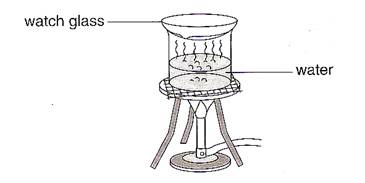
a) Using a dropper, add several drops of the filtrate to a watch glass.
b) Heat until all the water evaporates.
5. What remains on the watch glass? __________
6. Compare the results with those of other groups to see whose filters are most effective.
a) Filtering only removes ___________ (large/small) particles in water.
b) Filtering ____________ (does/does not) remove soluble substances in water.
B. Chlorination
1. Place a drop of the filtrate from Part A on a microscope glass as shown in the diagram below.
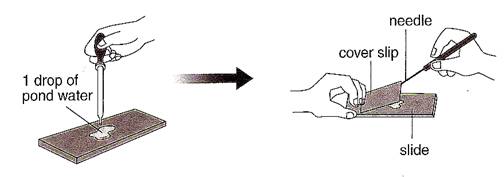
2. Look at the water through the microscope.
a) Do you see any living things? _______
b) Pond water ____________ (contain/does not contain) living things.
c) Filtering ___________ (does/does not) remove these things.
3. Your teacher will add a few drops of water containing dissolved chlorine to the pond water in the beaker.
4. Take a drop of the water and observe it under the microscope. Do not forget to use a cover slip.
a) Can you see any living things now? __________
b) Chlorine ________ (can/cannot) kill living things in water.
Attachment 6.A.2.2
Assessment Sheet: Elaboration
Subject Matter Area : Science
Topic :Water purification
Instructional Objective(s) :
- Understanding the purpose of treating raw water to ensure clean drinking water for everyone
- Realizing that water treatment are for the benefit of human health (for hygiene and sanitation purposes)
Assessment Procedures:
What |
How |
Who (assessor) |
a) Practical activity (Purifying Water) |
- Ask learners to carry out practical activity 7.7. (Attachment 6.A.2.1).
- Learners should be able to state that the muddy water is not clear and it is not safe for drinking.
- Learners should then be able to observe that the water is clearer after filtration. They should also understand that although the water looks clear, it may not be clean yet.
- Learners can investigate by examining under the microscope for any small/microorganisms that may be present. They should know by this stage that the water is not yet clean.
- Learners should then continue by adding chlorine to the water. They need to understand that this procedure kills any living microorganisms in the water. They should answer the questions given for this activity.
|
This can be assessed by the teacher. |
b) Explanation and Simulation (PowerPoint) |
Show learners slideshow or poster to describe the process of water purification |
The test enables to test learners’ conceptual understanding of the water purification process |
c) Closure (Snakes and Ladders activity-Attachment 3 |
Ask learners to participate in a board game (snakes and ladders) which shows examples of bad and good values concerning water.
- The aim of this activity is to promote the values and the learners’ related behaviours (rather than merely penalising negative behaviours).
- Learners are divided into smaller groups, each given the board game handout (Attachment 6.A.2.3), their marks and dice.
- The game should only take about 10 minutes. After that, learners are asked to share their views and their feelings about water wastage and pollution.
- Questions that can be directed to learners:
Q1. Which of the habits are worthy/unworthy of respect?
Q2. Are you willing to develop a much more positive approach on water purification and conservation? If so, how?
Q3. What aspects of water purification are important to hygiene and health?
- The post discussion allows learners to learn something about themselves by exploring how their feelings and emotions influence their behaviours and how their behaviours affect the world they live in.
|
This can then be assessed by peers |
Evaluation:
- The test: The learners’ marks will be evaluated by giving them a point for each correct answer for
- The snakes and ladders post-activity discussion can be assessed by the learners themselves, deciding what grade each learner should get (peers judge and grade according to their views/opinions they have written-with help from the teacher)
Attachment 6.A.2.3
Power Point Slide show can be shown
as poster and be written on whiteboard
TEST TIME
Let us find out how far you have followed the lesson
1. Click on the TRUE statements.
A. It is safe to drink rain water because it looks clean.
B. Rain water is suitable for drinking if it is filtered and boiled.
C. Treated water contains no microorganisms and no smell.
D. In water treatment, the mineral salts in the water are removed.
2. Which reservoir stores raw water?
A. Service reservoir
B. Raw water reservoir
C. Raw water mixing chamber
3. Which reservoir stores treated water?
A. Service reservoir
B. Raw water reservoir
C. Raw water mixing chamber
4. The process that takes place in the sand filters is
A. Filtration
B. Chlorination
C. Fluoridation
5. Which one shows the correct stages in water treatment?
A. Filtration à Sedimentation à Fluoridation à Chlorination à Coagulation
B. Filtration à Sedimentation à Coagulation à Chlorination à Fluoridation
C. Coagulation à Sedimentation à Filtration à Chlorination à Fluoridation
6. Which one shows the correct sequence of tanks in the waterworks?
P: Filtration tank Q: Clear water tank R: Raw water tank S: Settling tank
A. R à Q à P à S
B. R à S à P à Q
C. Q à P à S à R
7. Say out and spell the answers.
a. It is added to make the water less acidic. (MLEI).
b. It makes the tiny impurities to clump to form larger solid impurities. (LAUM).
c. This is the process where larger solid impurities are allowed to settle to the bottom of the tank. (DSTNIOETMEANI).
d. It kills microorganisms in the water. (IHCEOLNR).
e. This process makes use of sand beds to separate suspended fine impurities from the water. (NTAIIROFLT).
f. It is added to water to prevent tooth decay. (DRUFOILE).
g. The process of adding chlorine to water. (TCRINALNOOIH).
h. The process of adding fluoride to water. (LDANORTOUIIF).
Attachment 6.A.2.4
Snakes and Ladders Activity

A.3. Water, human dignity and social equity
A.3.1. Overview and background information:
Title of the lesson:
- Unit/Topic : Water and Solutions
- Sub-topic: Water in nature, the three states of water and Water Cycle
Background/context for particular lesson:
- Learners’ pre-requisite knowledge is on Form 1’s Topic: Matter, which includes water as a resource, States of Matter, Changes of matter.
Learning goals in the core learning area:
- To recognize usefulness of scientific methods and apply skills such as interpreting and drawing graphs and charts to classroom and everyday life
- To develop an informed interest in scientific matter, particularly that is related to the environment and demonstrate positive attitude towards its protection
Suggestions for variations of lessons:
- If internet connectivity is unavailable, the water poem can be printed out and photocopied for learners to share.
- For closure, teacher can introduce a scenario to the learners where one sells water bottles in the streets. It was late and he/she only had one water bottle left. He/she was approached by two different people, the first was an old lady who was short of 20 cents to pay for the water, but clearly needed the water. The second customer was a rich businessman, who obviously could pay for the water. Teacher asks learners “Who would you sell the water to and what are your reasons?”
Teachers Notes:
- Teacher needs to include these messages during the lesson:
- Water exists in all living things
- Water in human body, in animals, in plants
- Water plays an essential role in life à we all depend on water
- Teacher should be aware that this lesson plan needs to have internet connectivity
A.3.2. The Lesson plans
Subject Matter area |
Science |
Time duration |
Grade |
7 (Learners between the ages of 13-14 years old) |
|
Topic |
Water in nature, the three states of water and Water Cycle |
|
Specific concepts covered in the lesson |
- Water in nature
- The three states of water
- Evapouration
- Condensation
- Water Cycle
|
|
Underlying values/human values |
- The existence of water in the form of ice, liquid and steam (reversibility) and how we make use of this to make water available for human consumption
- Availability of drinking water depends on this water cycle, thus it is our duty to take care of it
- Be responsible to the environment (i.e. water) so that it can be shared by everyone
|
|
Lesson objectives |
At the end of the lesson, learners will be able:
- To explain the importance of water in nature (cognitive)
- To state the three states of water: solid (ice), liquid (water) and gas (steam) (cognitive)
- To observe the changes of water in different states of matter (with reference to boiling point, melting point and freezing point) (cognitive)
- To explain the different processes involved in water cycle in nature (cognitive)
- To demonstrate the changes in the states of water by boiling and freezing water (psychomotor)
- To affirm the fact that although water is recyclable, water consumption should still be controlled (affective)
|
|
Materials needed |
- Practical activity (Attachment 6.A.3.1): 1 conical flask, 1 filter funnel, 1 thermometer, 1 beaker glass, 1 Bunsen burner, 1 tripod stand, wire gauge, 1 stopwatch, pair of tongs, glass plate or tile, droppers.
- Internet access
|
|
Teaching - Learning Steps |
60 mins |
Introductory or motivational activities:
Content:
Closure:
Assessment / Evaluation
|
- In the form of verbal questions and answers, ask learners why water is essential for survival
- Provide pictures of people bathing, washing clothes, drinking, cooking, to emphasize on the importance of water to mankind.
- Then ask learners what they think and feel about the quotation below:
“Saving water is good for the earth, your family and your community”
- Let learners write down examples of values they think are strongly-related to this quotation (Linkage with human values).
Step 1 Practical activity (Attachment 6.A.3.1) on changes of states of matter
- Ask learners to set up apparatus as shown in the diagram on page 1 of LS Science Workbook. The melting of ice should indicate the change of water from solid to liquid. Learners should be able to answer the questions provided, including recording the melting point.
- Learners continue the practical work by boiling a beaker filled with one third of water. They should be able to record the boiling point, which is 100°C. This indicates the conversion of water to steam.
Take note:
- It is important to distinguish between evapouration and boiling. Evapouration is when water changes to gas (steam) at any temperature below the boiling point. Boiling means the change that occurs only at one temperature, which is the boiling point.
- It is also important to distinguish between water vapour and steam. Water vapour is the water in the air. Steam is when water boils and changes into gas.
- As a follow-up, learners are then asked to use a pair of tongs to hold a glass plate over the steam for a few seconds. Learners should be able to observe water droplets on the mirror, which indicates that the steam has condensed to water.
Step 2: PowerPoint Presentation/OHT on Water Cycle (Attachment 6.A.3.2)
- Discuss evapouration (relate to sweating and dehydration in human body) and water cycle in nature. Point out that energy from the sun keeps the cycle going.
- Briefly include a discussion of cloud formation due to condensation of water vapour as a result of cooling.
Take note:
If internet access is not available, water cycle diagram can be printed out and enlarged as a poster instead.
Step 3: Discussion of water poem (Linkage with human values)
- Click on the icon ‘Read a water poem’ from the website (Attachment 6.A.3.3) and ask learners to read it out loud.
- Teacher should lead the example by citing the first two lines of the poem wholeheartedly.
- Follow-up: Ask for learners’ reflections by asking questions:
- What do you think of the idea that the water that you drink now may be drunk by people or animals that lived long ago?
- What can you do to ensure that the water that you drink now can still be drinkable for your great great-grandchildren?
- Can you imagine what would happen to the world if the Water Cycle did not exist? What do you think would happen to the human race?
- From this discussion, learners may understand that availability of drinking water depends on this water cycle, thus it is our duty to take care of it.
- Summary in the form of concept map, using the terms below: three states of water, ice, water, steam, boiling point, melting point, evapouration, boiling, condensation, water cycle.
- Discussion of water poem and constructing concept map (already mentioned in step 3 and closure)
- Project on Creative Problem Solving (Linkage with human values): Take note of the following problem and work out a creative solution. In one country, situated near the sea, there has been no rain for over one year and there is a severe shortage of water for drinking and for growing crops. What can you do to help the people, especially the elders and the children?
- Guidelines as follows:
Define the problem à Ideas for solving the problem à List down possible solutions and the advantages and disadvantages of each solution à choose best solution with modifications if possible.
- This project is aimed at learners attempting to see the world through the eyes of others and to recognize the needs and concerns of others.
- This is to be done after the lesson as a ‘follow-up’ activity.
- Time-frame is one week.
|
5-7 mins
30-35 mins
10-15 mins
5-8 mins
10 mins
Homework |
Learners’ self-study |
Check out this website (http://www.epa.gov/safewater/kids/water_trivia_facts.html) which gives water trivia facts for learners wanting to learn extra information about water |
Lesson Evaluation |
Learning outcomes achieved |
|
Learners’ participation during lesson |
|
What needs to be improved |
|
Attachment 6.A.3.1
Practical Activity
A. The melting of ice
1. Set up the apparatus as shown in the diagram.
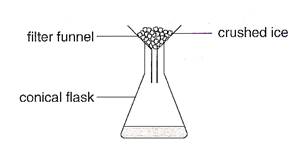
a) Add crushed ice to the funnel.
b) What goes through the funnel into the flask?
________________________________________________
2. Measure the temperature of the crushed ice using a thermometer.
a) At the temperature does the ice change into water? _________ °C
b) This temperature is called the _________ point.
3. Record the temperature at one-minute intervals for five minutes.
Time (mins) |
1 |
2 |
3 |
4 |
5 |
Temperature (°C) |
|
|
|
|
|
What happens to the temperature when water changes into ice?
______________________________________________________________
B. The boiling point of water
1. Set up the apparatus shown in the diagram below.
The beaker should be one-third full of water.
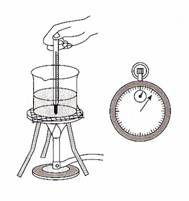
2. Heat the water and record the temperature every minute for 15 minutes.
Time (mins) |
1 |
2 |
3 |
4 |
5 |
6 |
7 |
8 |
9 |
10 |
11 |
12 |
13 |
14 |
15 |
Temperature (°C) |
|
|
|
|
|
|
|
|
|
|
|
|
|
|
|
In the experiment, the highest temperature recorded was _________ °C
1. Describe what happens to the water in the beaker at this temperature.
_______________________________________________________________
2. a) From the experiment, water changes to steam at _________
b) This temperature is called the __________ point.
C. Condensation
- Heat some water in a beaker until it boils.
- Use a pair of tongs to hold a mirror over the steam for a few minutes.
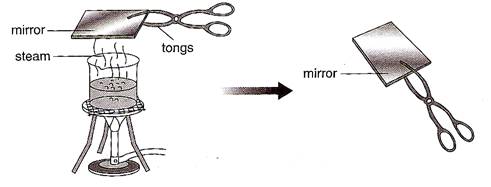
a) What do you observe on the glass plate? _________________
b) What happened to the steam? __________________________
D. Evapouration
Place a drop of water and a drop of ethanol separately on a glass plate.
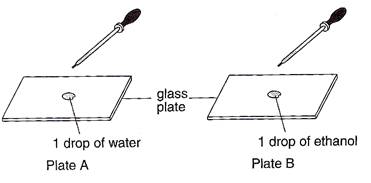
a) What do you observe after five minutes?
____________________________________________________________
b) What can you conclude from this experiment?
____________________________________________________________
Attachment 6.A.3.2
Power point: Water Cycle
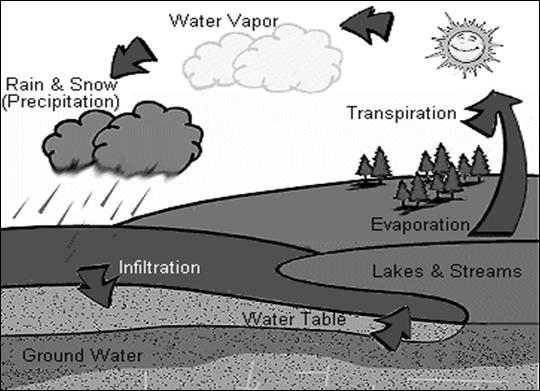
Attachment 6.A.3.3
Read the Poem of Water
Recycled
The glass of water you’re about to drink
Deserves a second thought, I think.
For Avogadro, oceans and those you follow
Are all involved in every swallow.
The molecules of water in a single glass
In number, at least five times, outclass
The glasses of water in stream and sea,
Or wherever else that water can be.
The water in you is between and betwixt,
And having traversed is thoroughly mixed,
So someone quenching a future thirst
Could easily drink what you drank first!
The water you are about to taste
No doubt represents a bit of waste
From prehistoric beast and bird—
A notion you may find absurd.
The fountain spraying in the park
Could well spout bits of Joan of Arc,
Or Adam, Eve, and all their kin;
You’d be surprised where your drink has been!
Just think! The water you cannot retain
Will some day hence return as rain,
Or be held as the purest dew.
Though long ago it passed through you!
Written by Verne N. Rockcastle
Attachment 6.A.3.4
Assessment Sheet: Elaboration
Subject Matter Area : Science
Topic :Water in nature, the three states of water and Water Cycle
Instructional Objective(s) :
- The existence of water in the form of ice, liquid and steam (reversibility) and how we make use of this to make water available for human consumption
- Availability of drinking water depends on this water cycle, thus it is our duty to take care of it
- Be responsible to the environment (i.e. water) so that it can be shared by everyone (sanitation purposes)
Assessment Procedures:
What |
How |
Who (assessor) |
a) Practical Worksheet -Changes of state of water |
- Ask learners to set up apparatus as shown in the diagram in the worksheet (Attachment 6.A.3.1). The melting of ice should indicate the change of water from solid to liquid. Learners should be able to answer the questions provided, including recording the melting point.
- Learners continue the practical work by boiling a beaker filled with one third of water. They should be able to record the boiling point, which is 100°C. This indicates the conversion of water to steam.
- As a follow-up, learners are then asked to use a pair of tongs to hold a glass plate over the steam for a few seconds. Learners should be able to observe water droplets on the mirror, which indicates that the steam has condensed to water.
|
This can be assessed by the teacher. |
b) Discussion of water poem |
- Click on the icon ‘Read a water poem’ from the website (Attachment 6.A.3.3) and ask learners to read it out loud.
- Teacher should lead the example by citing the first two lines of the poem wholeheartedly.
- Follow-up: Ask for learners’ reflections by asking questions:
- What do you think of the idea that the water that you drink now may be drunk by people or animals that lived long ago?
- What can you do to ensure that the water that you drink now can still be drinkable for your great great-grandchildren?
- Can you imagine what would happen to the world if the Water Cycle did not exist? What do you think would happen to the human race?
- From this discussion, learners may understand that availability of drinking water depends on this water cycle, thus it is our duty to take care of it.
|
Learners’ reflections based on the 3 questions from the poem can be written down as a journal, which can be assessed by the whole class in terms of a grade. |
c) Project on Creative Problem Saving |
- Project on Creative Problem Solving (Linkage with human values): Take note of the following problem and work out a creative solution. In one country, situated near the sea, there has been no rain for over one year and there is a severe shortage of water for drinking and for growing crops. What can you do to help the people, especially the elders and the children?
- Guidelines as follows:
Define the problem à Ideas for solving the problem à List down possible solutions and the advantages and disadvantages of each solution à choose best solution with modifications if possible.
- This project is aimed at learners attempting to see the world through the eyes of others and to recognize the needs and concerns of others.
|
This can then be assessed by the teacher in terms of a grade |
Evaluation:
- The practical work: The learners’ marks will be evaluated by giving them a point for each correct answer.
- The poem discussion can be assessed by the learners themselves, deciding what grade each learner should get (peers judge and grade according to their views/opinions they have written- with help from the teacher).
- Project on Problem-Saving: This can then be assessed by the teacher in terms of a grade.
A.4. Water in culture, traditions and religious practices
A.4.1. Overview and background information
Title of the lesson:
- Topic : Relationships of organisms with one another and with the environment.
- Sub-topic: Effects of humans on the ecosystem, Pollution and Conservation.
Background/context for particular lesson:
- Lower Secondary Science Form 2 Topic 7: Water and Solutions.
- Lower Secondary Science Form 3 Topic 13: Living things and their ecosystems.
- Topic 15 Biology 5090 Sub-topic Energy Flow.
Learning goals in the core learning area:
- To recognize usefulness of scientific methods and apply skills such as, critical thinking, research and reasoning to classroom and everyday life.
- To develop an informed interest in scientific matter, particularly that is related to the environment and demonstrate positive attitude towards its protection.
Teachers Notes:
- The following statement can be used as an introductory part for the lesson “Man has a fundamental right to satisfactory living conditions; thus he has a solemn duty to protect and improve the environment for now and the future”.
- The excerpt from the Holy Qur’an says “And we send down water from the sky according to due measure, and we cause it to soak into soil and we certainly are able to drain of with ease. With it we grow, for you Garden of date palms and vines; in them you have abundant fruits, and of them you eat and have enjoyment” (Surah Al-Mu’minin: verse 18:19).
A.4.2. The Lesson plan
Subject Matter area |
Biology |
Time duration |
Grade |
10 (16-17 year old learners) |
|
Topic |
Effects of Humans on the Ecosystem, Pollution and Conservation |
|
Specific concepts covered in the lesson |
- Deforestation and its effects on soil, climate and local human population
- Water pollution
- Conservation
|
|
Human values addressed |
- Having an understanding towards the possible adverse effects of human activities on the ecosystem
- Realizing how polluted water can be a source of disease
- Acknowledging the fact that recycling treatment of sewage saves water
- Being responsible and respect for others
- Caring towards each other and the ecosystem
- Being Cleanliness by avoiding water pollution
|
|
Lesson objectives |
At the end of the lesson, learners will be able:
- To describe the effects of humans on the ecosystem with emphasis on examples of international importance (Tropical rain forests, oceans and important rivers);
- To evaluate the effects of: water pollution by sewage, any inorganic waste and by nitrogen-containing fertilizers.
- To display understanding that being concerned about the ecosystem is central to good behaviour
|
|
Materials needed |
- Research materials about water ecosystems and factors that contribute to their pollution and destruction
- 3D-models need to be developed by teachers to show soil erosion and water pollution, if possible
- Computer with internet access (if available)
|
|
Teaching – Learning Steps |
60 mins |
Introductory or motivational activities
Lesson Proper

Closure:
Assessment / Evaluation
|
Linkage with human values:
Teacher begins by highlighting the practice of Islam in Bruneian schools, such as conducting daily prayers which require them to take their ‘wudhu’ (ablution). This indirectly should send the message that without “suci” water (clean water), there won’t be ‘cleanliness’ (physical and spiritual aspects). Refer to teacher’s notes.
Step 1: Brainstorming Session (Linkage with human values):
- Divide learners in groups
- Instruct learners to answer the following question:
Choose one common water pollutant (fertilizers, detergents, DDT, toxic chemicals, sewer sludge, radioactive wastes, beach erosion). and describe how it affects the ecosystem (e.g. reduce the oxygen content in water).
Take note:
Learners were told beforehand to research online and to bring any research materials for the lesson.
Step 2: Follow-up and ‘Application to life’ Activity
- After listing down the different pollutants and their adverse effects, move to ‘follow-up’ and ‘application to life activity’ (Attachment 6.A.4.1). This should be done by individual learners.
- This activity is aimed to develop awareness towards the value of right conduct in terms of water pollution and conservation
Step 3: Discussion on the important role of sewage treatment
- To learn about how sewage is treated, instruct learners to go to this website link: http://sorrel.humboldt.edu/~ere_ dept/marsh/flow1.html
- Teacher show the passage (Attachment 6.A.4.2) from the website (Linkage with human values):
Imagine life as a water droplet, after it has been treated, it is now possible to be used for drinking, washing, etc. but what happens after? It is discarded and thrown as sewage. Should it be forgotten? Shouldn’t we care for it after what we have used it in our everyday lives? What do you think will happen if many water droplets are treated this way and forgotten?
- Ask learners to prepare a 5-minute presentation about the purpose of treating sewage.
- Make sure to allow learners acknowledge that if sewage is left untreated, it represents a loss of water and possibility of the spread of disease.
- Raise issues about water supply and quality, environmental restoration, buffer zones and flood management.
- Emphasis on the importance of conserving water and how treating and recycling sewage is an important part to water conservation.
- This will be assessed by other groups within the class.
Read water pollution facts online
- Provide learners the link to this website (http://www.grinningplanet.com/2005/07-26/water-pollution-facts-article.htm)
- Emphasize the importance of water conservation and that it is our responsibility as the inhabitants of the earth to conserve it.
- Create a brainstorming session which involves cooperative learning and research (b).
- Group discussion and presentation (c).
|
5-7 mins
15 mins
10 mins
15-20 mins
5 mins or at home |
Lesson Evaluation |
Learning outcomes achieved |
|
Learners’ participation during lesson |
|
What needs to be improved |
|
Attachment 6.A.4.1
Follow-up and Application to Life activity
1. Design a card to be hung at home. Start with the verse ‘Right conduct is …”. You need to relate this to being responsible about water pollution and conservation.
Right conduct is… |
- Taking care not to throw rubbish into the river
…………………………………………………………. |
2. Share these ideas with the members of your family. Let their parent or guardian
__________________________________________________________
_____________________________________________________
Attachment 6.A.4.2
Appreciate Willy, the Water Droplet !
You know, life as a water drop sure isn't easy. So many people take me for granted and don't really think about the role I play in their survival. Many people will overuse me, pollute me, or even worse, boil me! Fortunately, there are some people in the city of Arcata, CA. that care about me. They appreciate the fact that I am a necessity in their every day lives. When F.O.A.M., or Friends of the Arcata Marsh, asked me to help them, I was more than happy to do so.
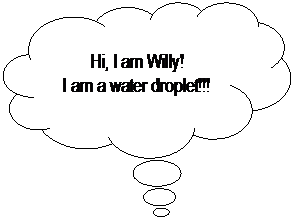

Attachment 6.A.4.3
Assessment Sheet: Elaboration
Subject Matter Area : Biology
Topic :Effects of humans on the ecosystem, Pollution and Conservation
Instructional Objective(s) :
Display understanding that being concerned about the ecosystem is central to good behaviour
Assessment Procedures:
What |
How |
Who (assessor) |
a) Brainstorming session |
- Provide learners with a blank card for Follow-up and Application to life activity worksheet (Attachment 6.A.4.1)
- Instruct them to make a card which demonstrates behaviour of right conduct towards the ecosystem
Once completed, let them bring home to their parent/guardian |
This can be assessed by their parent/ guardian who will give a grade. |
b) Discussion and group presentation on the important role of sewage treatment
|
- Display Attachment 6.A.4.2 to learners, which describes how a water droplet that undergoes treatment feels about being used by humans
- Pose the following questions to learners and let them reflect on them by writing down their feelings, which they will present:
Imagine life as a water droplet, after it has been treated, it is now possible to be used for wudhu, etc. but what happens after? It is discarded and thrown as sewage. Should it be forgotten? Shouldn’t we care for it after what we have used it in our everyday lives? What do you think will happen if many water droplets are treated this way and forgotten? |
The group presentation is assessed by other groups in the class |
c) Critical thinking write-up:
“You are living in a community which lacks water supply. You want the people living in the neighborhood to appreciate water. Explain how you would set up a campaign in order to educate the people about it”. |
- learners given the scenario so they can propose a way to solve the issue
- This assignment is aimed to allow learners to discover ideas on how to appreciate and maintain their environment to enhance their lives and those of future generations
|
This can then be assessed by another teacher teaching the same subject. |
Evaluation:
The learners’ marks will be evaluated by giving them a grade. The grades they obtained from the activities b) and c) will then be averaged.
|

















